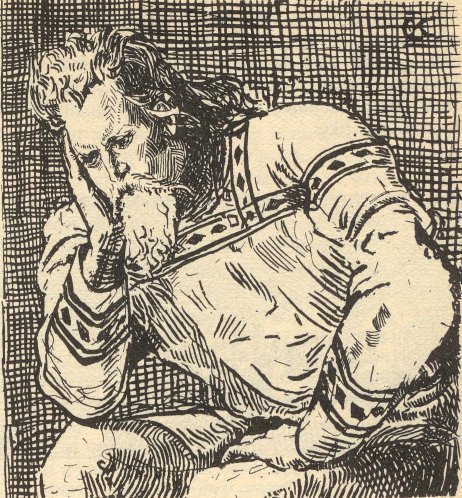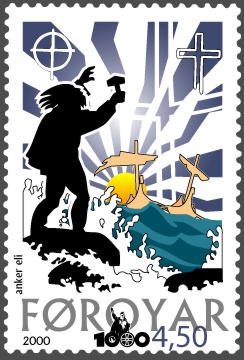
The statue of Sigmundr Brestisson in Tórshavn, Faroe Islands (Photo: Erik Christensen, CC BY-SA 3.0)
According to the unknown author of the Færeyinga saga (Faroese saga) written in Iceland sometime in the early thirteenth century, Sigmundr Brestisson, the first Christian of the Faroe Islands, was an honorable and good man. At a young age he and his cousin Thorer (Þórir) were sold into slavery by a chieftain named Thrand (Þrándr), who successfully plotted to have Sigmundr’s father killed in battle. Later as freemen, Sigmundr and Thorer fought bravely under Earl Hakon (Haakon Jarl) when he ruled Norway for two decades beginning around 975.

One day together, Sigmundr asked Hakon for advice on how to avenge his father’s death. Hakon replied that he should put his trust in the old ways, as he did, and led him into a forest where there was a beautiful house with “a lot of idols inside, and many glass windows… A woman was in the innermost part of the entrance, and she was richly adorned.” When the two men entered the house…
The earl threw himself down before her… and lay there for a long time; and then he got up and told Sigmundr that they should bring her some silver as an offering, and put it on the chair for her. “…that she will receive the tribute, and fulfill my wish,” continued the earl, “…notice that she then releases the [arm] ring which she has on her hand, and that ring, Sigmund! Shall bring you Luck.” And now the Earl went to the Ring; but he did not get it, and it seemed to Sigmundr that she clamped her fist at once. The earl threw himself down a second time for her, and Sigmund saw that the tears were in the eyes of the earl; and he then got up, and went to the ring, and then it was read, and he gave it to Sigmundr, and said that Sigmundr should not part with the ring, which Sigmundr promised.[1]
Sigmundr Christianizes the Faroes for King Olaf
Following Hakon’s demise, in 997, two years after Olaf Tryggvason became king of Norway, Sigmundr was summed and told by Olaf that to “become the most powerful man of the Faroes” he must become a Christian and convert the people who were part of his kingdom. To do this, Sigmundr had to convince his nemesis Thrand – who held sway over many of the Faroese. When Sigmundr arrived in the islands, he held an assembly and told the people of his task, but Thrand thwarted his efforts by persuading them against the king’s decree. Soon after, Sigmundr and thirty of his men sailed in bad weather to Thrand’s farm, circled it, broke down his door, and dragged him outside. Sigmundr offered Thrand a choice to “accept the true Faith… [or] be killed immediately on the spot… ‘for you will soon lose your great riches and the happiness of this world, and instead get the… eternal torment in the other world.’” Being a pragmatic man, Thrand reluctantly accepted to be baptized that night.
When Sigmundr returned to Norway to pay the king’s taxes he met Olaf in the capital of Nidaros (Trondheim). “The king received him well, and Sigmundr stayed with the king for a long time in the spring. Sigmundr told the king plainly all that had happened about the exchange with Thrand and other islanders.” The king answered that Thrand was “one of the worst men in all the north countries” but was happy that his subjects had become Christian and were paying taxes. One evening, while the two were drinking together, “Sigmundr laid his hands on the table. The king looked around and saw that Sigmundr was strong with a gold ring on his arm hand.” Olaf then said:
“Let me see the ring, Sigmundr!” He took the ring from his hand and handed it to the king. The king said: “Will you give me this ring?” “It has been my intention, Lord!” Replied Sigmundr, “not to part with this Ring.” “I will give you another Ring instead,” said the King, “and it shall be neither less [value] nor less beautiful.” Nary will I part with this,” said Sigmund, “I promised Hakon Jarl when he gave me the Ring, with much sincerity, that I should not part with it…” Then the king said, “Let him have it… for this ring will be your death.”[2]
The Fateful Swim to Suðuroy
Back in the Faroes, Thrand plotted his revenge. In 1005, a few years after being forcibly baptized, he and more than sixty men sailed to the island of Skúvoy at night and surprised Sigmundr at his farm. Thrand and his men chased Sigmundr and Thorer through a gorge until they were cornered next to a rock on a ledge near the sea. Thorer wanted to defend their position “as fate would make possible” but Sigmundr had lost his sword somewhere in the gorge and recommended they “jump down here from the cliff and try to swim away.”

According to the Færeyinga saga, the two plunged into the sea but Thorer quickly tired after the current pulled them from shore, and pleaded with Sigmundr to leave him: “How long will you, my cousin Sigmundr, drag a dead man after you? …All our lives… we’ve been together, and borne great love for each other, but now it seems that our togetherness is over now I have done everything I have endured; now I want you to save yourself and your life…” Sigmundr refused: “‘Either we should both come ashore, or neither of us.’ Sigmund then pushed Thorer between his shoulders… and swam” until they nearly reached the island of Suduroy (Suðuroy) – more than ten kilometers from their farm. During the entire night, while the waves threatened to sink them, Sigmundr kept the heavy golden ring on his arm:
Sigmund was then so exhausted… the waves washed Thorer off his shoulders, and he drowned, but Sigmund finally managed to crawl up, and was then so exhausted that he could not walk, but crawled up on the shore, and lay down in a seaweed heap. He lay there until daybreak. There was a small farm a short distance away on the island, which was called Sandvik, where a man lived, named Thorgrim the Evil, he was a large and strong man, and had his farm attached to Thrand… He had two sons, named Ormstein and Thorstein… In the morning Thorgrim the Evil One went to the shore, and had an axe in his hand: He then came to a place where he saw that a red cloth protruded from a pile of seaweed… and saw that there was a man lying. He asked who he was; Sigmund named himself… [and] told everything how it had gone. At once Thorgrim’s sons came. Sigmund asked them to help him, Thorgrim was not quick to answer it, but spoke softly… with his sons: “Sigmundr has, as I think, so much wealth on him,” he said, “that we have never been owners of so much, and his gold ring is very thick; it seems to me… therefore best that we kill him and hide him afterwards.”[3]
And thus King Olaf’s warning in Nidaros to Sigmundr came true – as the first Christian of the Faroe Islands was killed and buried at Sandvik that day. The golden ring was later found by Thrand at the farm, and the murderers were hung at the Thing in Torshavn after confessing to their crime. Thrand died an old and wealthy man.[4]
[1] Carl Christian Rafn, ed. Færeyinga saga eller Færøboernes historie [The Faroese saga or the history of the Faroese people] (Copenhagen: Director Jens Hostrup Schultz, 1833), 100-103.
[2] Ibid. 131, 142-153.
[3] Ibid. 167-177.
[4] See: Melissa A. Berman, “The Political Sagas.” Scandinavian Studies 57, no. 2 (1985), 124. In the saga Sigmundr “is painted in description and deeds as a champion. His opponent Þrándr [Thrand] is characterized as a sorcerer. But in Færeyinga saga, the honorable hero cannot survive in the imperfect world while his ruthless opponent manages all too well. Sigmundr relies naively on the strength of his arm and the nobleness of his cause. He dies young. Þrándr uses murder, guile, and witchcraft to keep his power until his death on his old age.”
0 thoughts on “The Cursed Ring of Sigmundr Brestisson, Viking Chief of the Faroes, 961-1005”